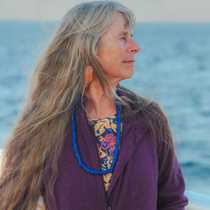Just before sunrise the Sea Lion lifted her anchor and began a slow passage away from Punta Belcher on her way towards a rendezvous with a Mexican pilot who would be navigating the Sea Lion through the Hull Canal during our morning passage to the northern end of Bahia Magdalena. We would be spending the morning transiting a narrow passage, very accurately marked, with bleach bottles, and steel drums leading our small vessel towards her afternoon anchorage at Boca de Soledad.
The Hull Canal is approximately fourteen miles long. It winds its way through ever shifting sandbars that are edged on either side with large and small Mangrove forests. This Mangrove system is home to a myriad of bird species, from great blue herons, to reddish egrets, marbled godwits, long-billed curlews, all in varying degrees of breeding plumage. A notable character amongst the bird species was the double crested cormorant, with highly distinctive nuptial plumes riding just above their eyes, and very visible while the bird was in flight! Many of us remained on the bow; binoculars poised on constant alert for the discovery of yet another feathered resident of the Mangrove forest running along both sides of the Hull Canal. Soon more landmarks were pointed out by the naturalists on the bow, and we were in the area that is considered the nursery for the California Gray whale; lying between Devil's Bend, a deep turn in the middle of the Hull Canal and the boundary island of La Florida, located at the northern end of the Hull Canal. In this area we began to see the surfacing of cow/calf pairs as female Gray whales moved their young babies, less than two weeks in age, in and around the sheltered waters of this protected area.
Our afternoon would be spent in Zodiacs watching Gray whales, and also wandering the enormous expanse of beach that makes up the northern end of the Isla Magdalena. This barrier island wraps very closely to the Baja peninsula, creating the quiet waters of Bahia Magdalena and also a very interesting ecosystem of sand dunes and Mangroves. Hikers anxious to explore the otherworldliness of the dunes under gray skies and soft winter rain were loaded into Zodiacs and quickly dropped off on the beach with a naturalist.
The remaining members of our group entered our four Zodiacs and began a two hour tour of the Boca. Moving at water level we moved in for closer looks at this well observed marine mammal, who has made the longest migration of any animal on the planet. These whales travel approximately 110 miles a day to complete a one way migration of five to six thousand miles from the Chukchi and Bering seas to arrive here in Bahia Magdalena to give birth and partake in the annual rituals of courting and mating!The land lovers slowly moved off of the Zodiac landing sight and headed for a small stand of Mangroves for closer observation. We found two distinctive species of Mangrove, surviving quite well in their salt-water environment. Decorating these two distinctive shrubs, the White and Red Mangrove were lacey light-gray branches of an unusual species of lichen called "orchilla."
The sand and air were moist with a light rain, and everywhere we turned we found small sand crabs playing hide and go seek from depressions in the sand! Coyote footprints were running in every direction along with the tiniest footprint known to a tracker, that of the White-footed mousie! Due to the low light of this gray on gray day, colors were very vivid…..especially on the shells scattered profusely all over the beach! Beach combers united into a collective with one purpose, a still life showing of not only color but the diversity of mollusks, echinoderms, and arthropods that make their living near the pounding surf of the Pacific Ocean. Once the still life was completed, allowing for the placement by many hands, two of our smallest and most expert collectors agreed quite gleefully to pose with our individual treasures. Each shell a gift from the sea, found with attentive eyes, was carried and carefully placed amongst the other jewels. They would all be remembered, along with rain drops on sand dune patterns and a day of soft, moisture laden air that wrapped around each of us like a soft threadbare quilt...




